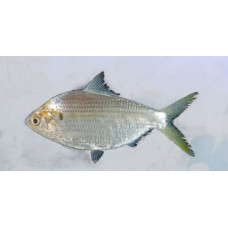Latin name
Anodontostoma chacunda
Other names
Anodontostoma chacunda
Identification
The depth of the body increases with the size of the fish, from 40 to 70% of the standard length in fish over 10 cm. The second supra-mandibular bone is a simple rail. The longest gill stamens in the lower part of the arch are smaller than the corresponding gill filaments. Posterior margins of scales dentate, denticles thinner than spaces between them; median row of predorsal scales.
Features of fish fins
Dorsal spines (total): 0; Anal spines: 0; Anal soft rays: 17-25.
Fish colouring
Have a large black spot behind the gill slit.
Distribution
Occurs in the Indo-West Pacific, mainly from the Persian Gulf to the coasts of India and the Andaman Sea. It has also been reported from the Gulf of Thailand, Indonesia, Vietnam, the Philippines, south to northern Australia, the Caroline Islands and New Caledonia.
Habitat
Tropical marine pelagic-neritic migratory fish. Depth range from 0 to 50 m. Inhabit coastal areas, sometimes entering rivers and estuaries.
Size
Reach a size of 22 cm with an average size of 14 cm.
Behavior
Usually inhabits the sea shore, but comes up rivers into the upper intertidal zone.
Food and feeding habits
It feeds on diatoms, radiolarians, mollusks, paddlefish and crustaceans.
Reproduction
It breeds from November to February.
Fishing
It's coming out for commercial purposes.
Relationship with a person
It is widely used in cooking.
| Classification | |
| Phylum | Chordata |
| Class | Actinopterygii |
| Squad | Clupeiformes |
| Family | Dorosomatidae |
| Genus | Anodontostoma |
| Species | A. chacunda |
| Features | |
| Conservation status | Least Concern |
| Habitat | Pelagic |
| Life span, years | No information |
| Maximum body weight, kg | No information |
| Maximum length, cm | 22 |
| Sailing speed, m/s | No information |
| Threat to people | Edible |
| Way of eating | Planktonophage |
Chacunda gizzard shad
Tags: chacunda gizzard shad

